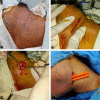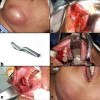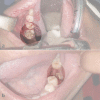Intra-oral Drainage of Submandibular Abscess: A Minimally Invasive Technique. A Prospective Study
- PMID: 38440448
- PMCID: PMC10908751
- DOI: 10.1007/s12070-023-04119-z
Intra-oral Drainage of Submandibular Abscess: A Minimally Invasive Technique. A Prospective Study
Abstract
Purpose: To evaluate the efficacy of intraoral drainage of isolated submandibular space abscess as a minimally invasive surgical technique compared to the standard trans-cervical approach.
Patients and methods: This prospective study included 40 subjects with isolated submandibular space abscesses. They were randomly divided into 2 equal groups: trans-cervical surgical drainage (group A) and intra-oral surgical drainage (group B). The included data were demographics, repeated surgery requirement, postsurgical hospitalization duration, formation of scar, and complications.
Results: Intraoral drainage (Group B) reduced the mean operative time by 15.25 min (P < 0.001) compared with trans-cervical incision (Group A). No considerable difference was found between the 2 groups in regarding hospitalization postoperatively. No weakness in marginal mandibular nerve was found in both groups. Three patients only have a cervical scar in a group (B) who required external drainage due to recollection. No recurrence was detected in a group (A).
Conclusion: The current study demonstrated that isolated submandibular abscesses can be successfully managed with an intraoral drainage modality, and it is a better option than the trans-cervical approach regarding better cosmetic outcome and shorter operative time.
Keywords: Abscesses; External approach; Intraoral; Submandibular space.
© Association of Otolaryngologists of India 2023. Springer Nature or its licensor (e.g. a society or other partner) holds exclusive rights to this article under a publishing agreement with the author(s) or other rightsholder(s); author self-archiving of the accepted manuscript version of this article is solely governed by the terms of such publishing agreement and applicable law.
Conflict of interest statement
Competing InterestsNone to declare. This study was conducted using the available resources at Cairo University Hospitals. The authors do not have any conflict of interest to declare. No author identifying information is present anywhere in the blinded manuscript.
Figures




Similar articles
-
Submandibular space abscess: a clinical trial for testing a new technique.Otolaryngol Head Neck Surg. 2012 May;146(5):716-8. doi: 10.1177/0194599811434381. Epub 2012 Jan 20. Otolaryngol Head Neck Surg. 2012. PMID: 22267495 Clinical Trial.
-
Risk factors for transcervical incision and drainage of pediatric deep neck infections.J Pediatr Surg. 2018 Apr;53(4):666-670. doi: 10.1016/j.jpedsurg.2017.06.013. Epub 2017 Jun 27. J Pediatr Surg. 2018. PMID: 28688792
-
Relative incidence and alternative approaches for surgical drainage of different types of deep neck abscesses in children.Arch Otolaryngol Head Neck Surg. 1997 Dec;123(12):1271-5. doi: 10.1001/archotol.1997.01900120015002. Arch Otolaryngol Head Neck Surg. 1997. PMID: 9413352
-
Transperineal drainage of prostate abscesses: A minimally invasive, low-risk management strategy that yields satisfactory results.BJUI Compass. 2023 Nov 27;5(2):207-216. doi: 10.1002/bco2.310. eCollection 2024 Mar. BJUI Compass. 2023. PMID: 38371211 Free PMC article. Review.
-
Abscess Management: An Evidence-Based Review for Emergency Medicine Clinicians.J Emerg Med. 2021 Mar;60(3):310-320. doi: 10.1016/j.jemermed.2020.10.043. Epub 2020 Dec 6. J Emerg Med. 2021. PMID: 33298356 Review.
References
-
- Grodinsky M, Holyoke EA. The fasciae and fascial spaces of the head, neck and adjacent regions. Am J Anat. 1938;63(3):367–408. doi: 10.1002/aja.1000630303. - DOI
LinkOut - more resources
Full Text Sources
